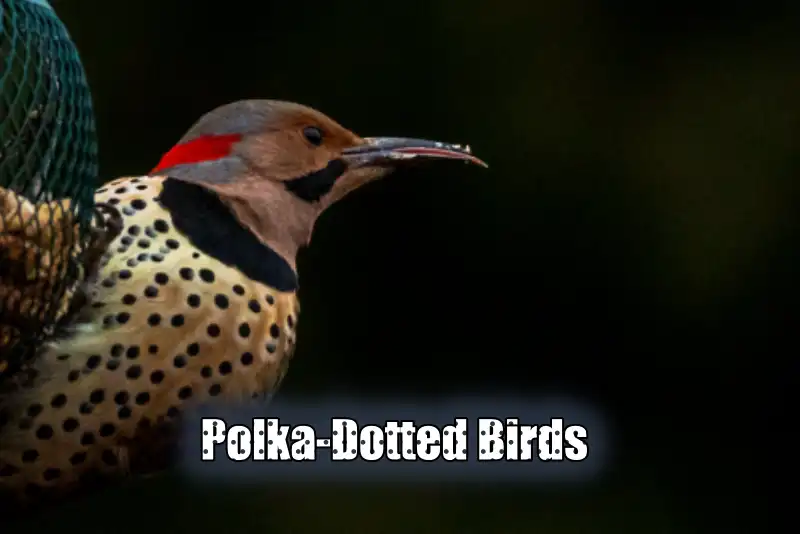More mysteries regarding the appearance and eating habits of animals will come to light as you delve deeper into the world of animals. During my childhood, I loved polka-dotted patterns a lot. Recently, during my field visit, I came across western Tragopan.
This bird’s polka-dot design instantly transported me back to my early years, which astounded me. I did more research on it and discovered that some birds with similar spotted patterns exist.
Here is the list of 12 polka-dotted birds that exist on earth.
12 Polka-Dotted Birds
1. Northern flicker
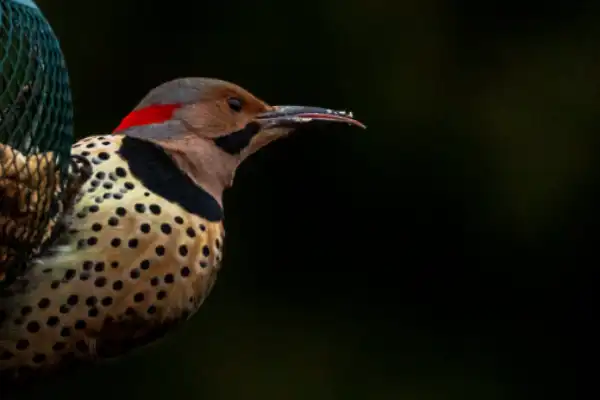
| Scientific name | Colaptes auratus |
| Size | 28–36 cm (11–14 in) |
| Geographical Location | Canada, southern Labrador, Newfoundland, and the northeastern United States |
| Habitat | woodlands, forest edges, and open fields |
The first bird we have on our list of polka-dotted birds is the Northern Flicker. The characteristic polka-dot pattern on the ventral side of these woodpeckers’ feathers is well known.
Brown coloration, a black-tipped tail and a black or red moustache that run along from their beak to their cheeks make them distinct.
These migratory, diurnal animals display aggressive behavior against their opponents by poking or pointing their bills.
They love to feed on a lot of items, like grasshoppers, crickets, ants, termites, wasps, aphids, beetles and their larvae, caterpillars, and spiders.
2. Western Tragopan
| Scientific name | Tragopan melanocephalus |
| Size | 48 to 60 cm |
| Geographical Location | Indus-Kohistan district, north Pakistan, east through Kashmir, Himachal Pradesh, to Bhagirathi River in Uttarakhand, north-western India |
| Habitat | Dense understorey of temperate, subalpine and broad-leaved forest |
Look at the picture of this bird. It’s amazing, isn’t it? This Himalayan bird has a lot of unexpected traits.
Their bodies are dark in color, resembling dark gray or black, and they exhibit white spots all over, bordered by black lines.
Females exhibit duller coloration than males. On their wings, females also display vermiculation.
This vulnerable species is now in danger, with less than 5000 individuals left inhabiting temperate forests.
3. Helmeted Guinea Fowl
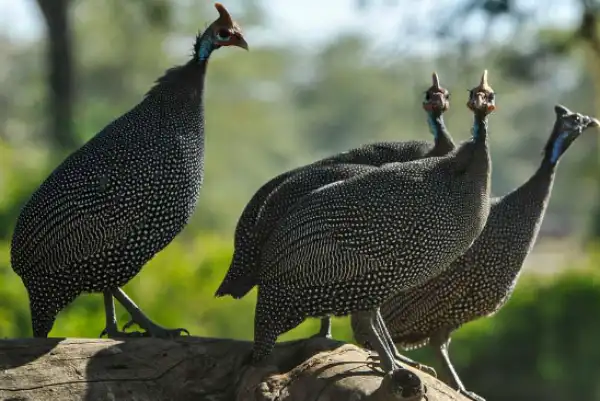
| Scientific name | Numida meleagris |
| Size | 53 to 58 cm (21 to 23 in) |
| Geographical Location | South of Sahara |
| Habitat | Warm, fairly dry and open habitats like savanna or farmland |
Helmeted Guinea fowl, as their name implies, are called so due to the bony crest on the top of their heads that looks like a helmet.
They have lovely white spots all over their bodies, as you can see above, giving them a polka-dotted look.
The most interesting thing about them is that their diet changes according to their breeding season. Prior to mating season, they eat more plant-based foods like maize, tubers, seeds, etc., but during breeding season, they only eat insects, particularly beetles.
4. Pink-throated twinspot
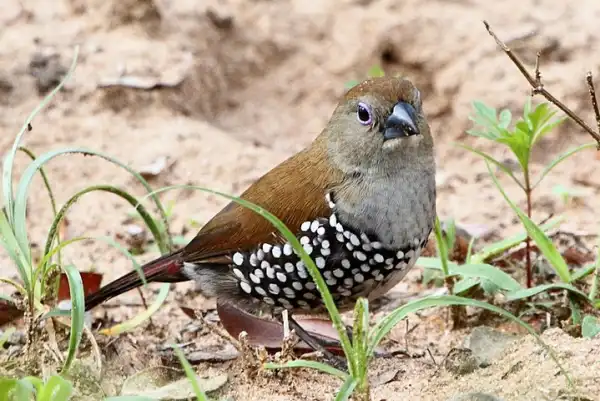
| Scientific name | Hypargos margaritatus |
| Size | 12–13·5 cm |
| Geographical Location | South Africa, Mozambique |
| Habitat | Dry savanna and moist, subtropical/tropical shrubland |
The prominent, bright pink or rose-colored throat makes the pink-throated twinspot finch distinctive.
One can spot them on the southeast African coast of Mozambique, South Africa and Eswatini, where they inhabit wide varieties of habitats like dry savanna and moist, subtropical or tropical shrublands.
When you look closely, you’ll notice that they have polka patterns on their plumage, which helps them blend in with their environment or attract partners.
5. Red and Yellow Barbet
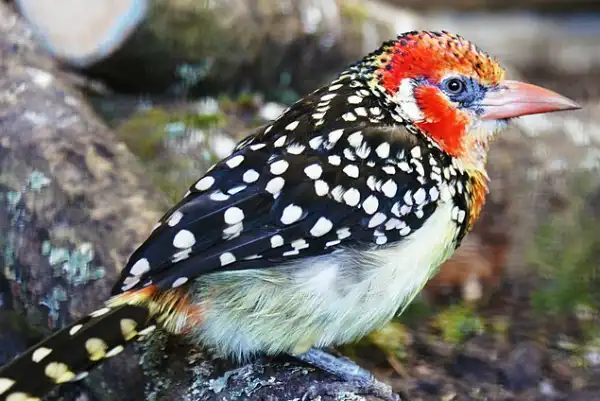
| Scientific name | Trachyphonus erythrocephalus |
| Size | 20–23 cm |
| Geographical Location | Eastern Africa |
| Habitat | Dry savannah, desert, and scrublands |
The red and yellow barbet is a species of African barbet that belongs to the family Lybiidae.
Males of this bird species are brightly colored, with black, red and yellow hues. Whereas females are duller than males, when you see them from the back, you can see the white spots all over their black coloration, which gives them a characteristic polka-dotted appearance.
These omnivorous creatures like to feed on seeds, fruit, and invertebrates.
6. Red Munia
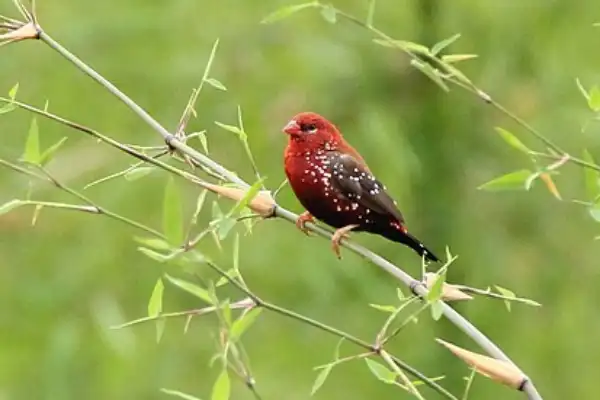
| Scientific name | Amandava amandava |
| Size | 9·5–10 cm |
| Geographical Location | China, India, Bangladesh, Cambodia, Indonesia, Myanmar, Nepal, Thailand, Timor-Leste, Vietnam, and Pakistan |
| Habitat | open fields and grasslands of tropical |
Red avadavat, red munia, and strawberry finch are some of the common names of Amandava amandava.
You must have seen this bird with bird lovers, as they love to keep them because of their alluring appearance.
These species’ males have brilliant red coloring, brownish-green wings, and a black line around their eyes.
The white spots, or polka dots, are just the icing on the cake.
7. Painted firetail
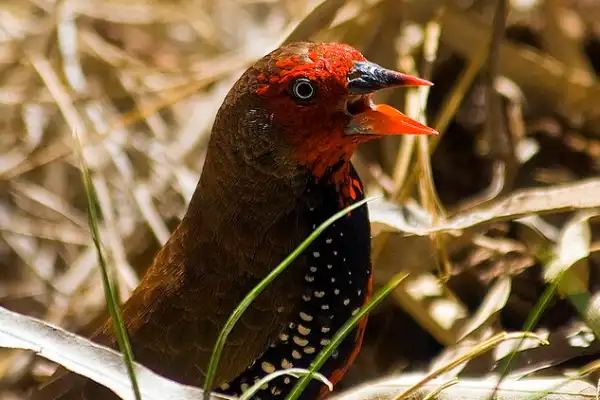
| Scientific name | Emblema pictum |
| Size | 10–12 cm |
| Geographical Location | Western Australia, Northern Australia, Queensland and South Australia |
| Habitat | Arid and semi-arid zones in rocky areas |
You can find them in small flocks in Western Australia, Northern Australia, Queensland and South Australia, inhabiting arid and semi-arid zones.
Juvenile plumage is very similar to that of females, whereas males are brighter in color. Males have a red face, forehead and breast, which make them distinct yet elegant.
Not only this red coloration but also that polka pattern on their feathers beneath the wings are just cherry on top.
They are architects, I must say; just have a peek at their bottle-shaped nest with an entrance painted with charcoal.
8. Peter’s twinspot
| Scientific name | Hypargos niveoguttatus |
| Size | Around 5 inches |
| Geographical Location | Angola, the Democratic Republic of the Congo, Kenya, Somalia, Tanzania, Zambia and Malawi |
| Habitat | Lowland evergreen thickets, riparian forest, forest edge |
This species’ male, with his gray crown and crimson hood, is a magnificent piece of art.
Look at their picture, and you will get to know why I am calling them art.
They have such a bright plumage with white polka-dotted feathers on their ventral surface, which makes them more incredible.
Their remarkable qualities have also made them well-known among animal enthusiasts.
9. Spotted Pardalote
| Scientific name | Pardalotus punctatus |
| Size | 8 to 10 cm (3.1 to 3.9 in) |
| Geographical Location | Eastern and southern Australia |
| Habitat | Tall open forests and sparse low woodland |
People sometimes refer to them as diamondbirds because of their colorful appearance.
We are in awe of them due to their grayish brown plumage with a pattern of white spots on their forehead and wings.
Females are duller than males. Females have more finer spots than males.
The reddish rump on the tail of a male is their characteristic feature.
They are univoltine and deposit three to four glossy white eggs in their horizontal oval chamber once a year.
10. African Penguin

| Scientific name | Spheniscus demersus |
| Size | 60–70 cm (24–28 in) |
| Geographical Location | Port Elizabeth, South Africa |
| Habitat | flat, sandy areas |
African penguin, Cape penguin or South African penguin are some of the common names of Spheniscus demersus.
They can grow up to 60 to 70 cm, with an average beak size of 20 to 30 cm. As you can see in the image above, the sweat gland that has become pink from increased blood flow is located over their eye.
Males are different from females in terms of their body and beak length. Upon closely inspecting their breast region, you will notice the black dots that aid in their mutual recognition.
They are the only penguin species that exist in Africa and can be seen in Port Elizabeth, South Africa.
11. Red-eared Firetail
| Scientific name | Stagonopleura oculata |
| Size | up to 125 mm |
| Geographical Location | Southwest Australia |
| Habitat | Wetlands of coastal and sub-coastal regions |
By their appearance, they look like relatives of the above species, right? Yes, this finch-like species is commonly found in Southwest Australia, inhabiting coastal to sub-coastal regions.
People also know them by the name Boorin. Check out their appearance now. From above, they have an olive brown color, while the remaining areas are black with white patterns that resemble polka dots.
They are known as red-eared firetails as the red patch is present just behind their eyes.
Usually, they are not frequently observed in captivity because they are so gregarious and bashful that they get anoxic when someone approaches them.
They enjoy eating seeds, twigs, and lower or fallen branches.
12. Blue whistling thrush
| Scientific name | Myophonus caeruleus |
| Size | 31–35 cm (12–14 in) |
| Geographical Location | Afghanistan, Bangladesh, Bhutan, Cambodia, China, Hong Kong, India, Indonesia, Kazakhstan, Laos, Macau, Malaysia, Myanmar, Nepal, Tajikistan, Thailand, Tibet, Turkmenistan, Pakistan and Vietnam. |
| Habitat | Temperate and tropical montane forests |
You must know about the blue whistling thrush; we covered them in another article. Again, we are taking them as an example of polka-dotted feathers.
Their polka-dot patterns are not as distinctive as those of other birds. But when you look at them from afar, they appear like polka dots, but from closer, they are just the shiny specklings.
Regarding their looks, their dark blue hue exquisitely showcases the white, glossy specklings on their heads, leaving us in awe.
Their golden beak sets them apart from the others. As their name suggests, during their mating season, which runs from April to August, they would sing at dawn and dusk.
Conclusion
Now that we have come to the end of this article, I hope you find it interesting to see your favorite pattern on their feathers.
Although the polka dots on a bird’s feathers are not very noticeable, their structure is.
I hope this post on polka-dot birds is interesting to you. Enjoy this until we return with another story shortly.
Also Read:

Being a zoology student I’m always been fascinated toward animals especially insects. I love to do research and learn about different animals. As a writer I want to share my thoughts about nature through my articles. Apart from this you can find me exploring the new places and voice notes.
